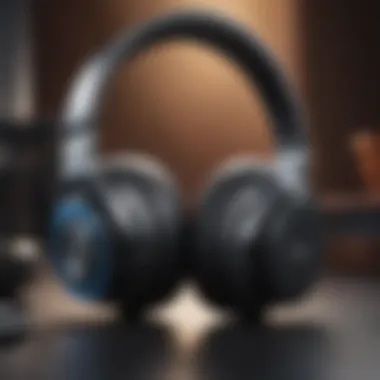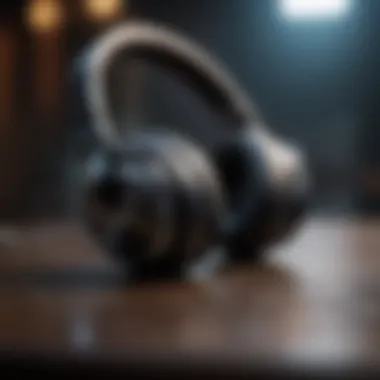How to Connect Bluetooth Headphones to Your iPhone


Product Overview
Connecting Bluetooth headphones to an iPhone is something many users consider essential. Apple’s mobile devices have transformed over the years, but the ease of connecting wireless audio remains a cornerstone of its user experience. This section serves to lay out what you might expect when connecting Bluetooth headphones to your iPhone, and it also prepares you for the journey ahead.
Prelims to the iPhone
The iPhone is a renowned line of smartphones that started as a revolutionary product back in 2007. With each new iteration, Apple has consistently refined its design, functionalities, and overall user experience. This not only applies to the elegant finish of the phone but also to its internal architecture, which seamlessly integrates with a range of compatible accessories—Bluetooth headphones being one of the most popular.
Key Features and Specifications
The iPhone's specifications make it a powerhouse for audio streaming:
- Bluetooth Version: Most recent iPhones utilize Bluetooth 5.0, allowing for an extended range and better connectivity.
- Audio Quality: Support for advanced audio codecs such as AAC ensures improved sound fidelity.
- Battery Life: Depending on the model, battery longevity allows for hours of uninterrupted music listening.
Design and Aesthetics
Apple prides itself on a sleek aesthetic. The iPhone’s minimalist design complements the sleek look of modern Bluetooth headphones. Whether you’re sporting AirPods or a pair from another brand, the visual synergy between these devices enhances the overall listening experience.
Performance and User Experience
The performance of connecting Bluetooth headphones to the iPhone usually impresses. Most users appreciate the quick setup and reliability of the connection.
Performance Benchmarks
The pairing process is generally swift. Users can typically connect their devices within moments:
- Activate the headphones and put them in pairing mode.
- Open Bluetooth settings on the iPhone.
- Select the headphones from the list and connect.
User Interface and Software Capabilities
Apple’s iOS interface is user-friendly. Features like automatic device switching, controls for music playback, and built-in voice assistance add layers of functionality. These characteristics often delight both casual listeners and audiophiles.
User Experiences and Feedback
Feedback from users indicates a high level of satisfaction. Reviews often highlight the lack of delays in audio playback and the overall sound quality served up by compatible Bluetooth headphones. Some users express their preference for Apple’s ecosystem, noting how effortlessly devices work together.
Tips and Tricks
Understanding how to get the most out of your Bluetooth headphones is not just about connecting them. There are several tips and tricks that can enhance your experience:
- Cleaning the Headphones: Keep them free from debris for optimal sound performance.
- Firmware Updates: Regular firmware updates can resolve compatibility issues.
- Control Settings: Customize how your headphones work through the iPhone’s settings to make every listening session perfectly tailored to your preferences.
Troubleshooting Common Issues
Even the best technology can sometimes throw a curveball. Here are a few common troubleshooting steps:
- If headphones don’t connect, try restarting both the iPhone and the headphones.
- Ensure the headphones are fully charged.
- Check if any other devices are interfering with the connection.
Latest Updates and News
Tech never stays stagnant. Regular updates from Apple generally include enhancements that can affect the Bluetooth experience:
- Software Updates: These can resolve bugs and improve connectivity features.
- New Product Launches: Apple continues to innovate in the audio space, so staying on top of announcements, like new headphones or updates to existing ones, is wise.
Industry News and Rumors
With Apple's reputation for innovation, there's always chatter around what they'll release next. Keep an eye on tech news platforms for rumors about upcoming products and features.
"The convenience of Bluetooth headphones has made them a lifeline for on-the-go users, allowing for a seamless transition from work to leisure."


Understanding Bluetooth Technology
Bluetooth technology plays a pivotal role in modern wireless communications, especially when it comes to linking devices like headphones to smartphones. With an increase in portable devices, understanding how Bluetooth operates can significantly improve your user experience. In this section, we dissect the fundamentals of Bluetooth technology, explain its workings, and discuss the advantages of utilizing Bluetooth headphones.
What is Bluetooth?
Bluetooth is a short-range wireless communication technology designed to facilitate data exchange between devices over short distances. It connects everything, from headphones to wearable health monitors, without the hassle of wires. Originally developed in the 1990s, Bluetooth has evolved substantially, enhancing its range, data transfer speed, and energy efficiency.
In its essence, Bluetooth creates a secure connection between your iPhone and Bluetooth headphones, typically using a radio frequency. Once connected, your iPhone can transmit audio data directly to the headphones, allowing you to listen to music or take calls without missing a beat. The charm of Bluetooth lies in its simplicity—pairing devices generally requires just a few taps on your screen.
How Bluetooth Works
Understanding the intricacies of how Bluetooth functions can clear up some common confusion among users. At its core, Bluetooth operates using radio waves in the 2.4 GHz frequency range. Once you turn on Bluetooth on your iPhone, it begins to search for nearby devices that are also discoverable. This is where pairing comes into play.
When you attempt to connect your Bluetooth headphones, your iPhone sends out signals to locate them. If they are in pairing mode, they respond back. Both devices negotiate a connection and create a secure link. After the initial pairing, your iPhone will remember your headphones, making it easier to connect in the future. This efficacy is what makes it seamless, so you can jump right into your favorite music or podcasts without fussing with cables.
Bluetooth can handle multiple devices at once, seamlessly switching between them without major hiccups. Notably, this is helpful if one uses several Bluetooth devices—like headphones, smartwatches, or speakers—concurrently.
Advantages of Using Bluetooth Headphones
The perks of opting for Bluetooth headphones are manifold. To name a few:
- Freedom of Movement: Gone are the days of tangled cords. Bluetooth gives users the liberty to move around without worrying about snagging a cable. This feature is particularly useful during workouts or daily commutes.
- Enhanced Portability: Bluetooth headphones are generally more lightweight and convenient to carry than their wired counterparts. Ideal for travelers, they often come with compact charging cases.
- Compatibility Across Devices: Most modern smartphones, tablets, and laptops support Bluetooth. This means you can use the same pair of headphones with multiple devices easily, which is quite the win in efficiency.
- Built-In Controls and Features: Many Bluetooth headphones come equipped with built-in features, such as voice assistants or playback controls, which add to the user experience. These additional functionalities often aim to enhance ease of use, making your time with tech a whole lot smoother.
"Bluetooth technology opens the door to a myriad of possibilities, making daily tasks simpler while keeping you connected, free and flexible."
In summation, understanding Bluetooth technology is vital for anyone looking to maximize their use of Bluetooth headphones with an iPhone. Grasping the basics of Bluetooth not only helps in troubleshooting issues but also enriches your overall audio experience.
Preparing Your iPhone for Bluetooth Connection
Connecting Bluetooth headphones to your iPhone is not just about pressing a few buttons. To ensure a smooth experience, there are several preparatory steps to consider. These actions can significantly enhance the reliability of the connection and the quality of audio. Skipping any of them may lead to a frustrating experience, where you constantly find yourself shouting into the void, struggling with dropped signals or poor sound quality. Here’s why preparation matters:
- Efficient Transition: By preparing your device, you streamline the connection process, making it as seamless as possible.
- Enhanced Performance: An updated and well-configured device performs better, which results in clearer audio and less interference.
- Avoiding Frustration: A bit of groundwork saves you headache later when you’re trying to enjoy your favorite tunes.
Updating iOS for Optimal Performance
Keeping your iPhone's iOS updated is crucial for optimal performance, especially when connecting to Bluetooth devices. Apple routinely releases updates that fix bugs and improve compatibility with new technology. An outdated iOS can lead to glitches or connectivity issues when pairing with Bluetooth headphones.
- Check for Updates: Go to Settings > General > Software Update. If there’s a new version of iOS, tap "Download and Install".
- Benefits of Updates: These updates enhance Bluetooth performance and may introduce new features.
Even if you think your phone is working fine, it’s worth checking. Like the saying goes, "A stitch in time saves nine"—addressing this early on spares you future problems.
Checking Bluetooth Settings
Next up is ensuring that your Bluetooth settings are correctly configured. This might sound straightforward, but it lays the groundwork for an easy pairing process. Head to Settings > Bluetooth and make sure Bluetooth is turned on. Your iPhone should be visible to other devices.
- Bluetooth Visibility: For pairing to occur, your iPhone needs to be discoverable. If it’s set to hidden, your headphones won't see it.
- Device List: Look for any previously paired devices. Sometimes, old connections can cause confusion or interruptions with new devices.
Having the right settings is like making sure you've put the right keys in the ignition; if the key's not right, the car won't start.
Ensuring Battery Life is Sufficient
Before attempting to connect, check that your iPhone has enough battery life. Bluetooth headphones also need juice to function; therefore, ensure that both devices are adequately charged. A low battery can lead to cutting out during playback or even failed connections.
- Charge Levels: A good rule of thumb is to have at least 20% battery on your iPhone. This gives room for prolonged use without interruptions.
- Charger Usage: If you're low on battery, consider plugging in your iPhone while setting up the Bluetooth connection.
This small step can save you from a situation where your music stops midway through a favorite track, leaving you mid-verse in a state of disarray.
Connecting Bluetooth Headphones to iPhone


Connecting Bluetooth headphones to an iPhone has become a crucial part of everyday life for many users. With high levels of reliance on mobility and convenience, understanding how to link these devices efficiently can elevate a listening experience significantly. Whether you're enjoying a podcast during your commute or diving into a favorite playlist while hitting the gym, clarity of sound and ease of use are paramount. The ability to link these headphones not only complements the iPhone's sleek design but also maximizes its potential as a multifunctional device.
One significant aspect of connecting headphones to an iPhone is the liberation from tangled cords. Wireless headphones offer the freedom to move without the encumbrance of cables, which is especially beneficial for those on the go. However, pairing requires a bit of knowledge about Bluetooth technology and the steps involved in the process. Here, we will dive into three key areas: the step-by-step pairing process, accessing the Control Center for quick connections, and misc ways to navigate Bluetooth settings on the iPhone.
Step-by-Step Pairing Process
Pairing Bluetooth headphones with your iPhone can seem daunting at first, but it is simpler than it might appear. To begin, follow these orderly steps:
- Put Your Headphones in Pairing Mode: Typically, you need to hold down the power button or the designated pairing button on your headphones until you see a blinking light, which indicates they are ready for connection.
- Open Settings on Your iPhone: Tap on the settings icon to access a range of options.
- Select Bluetooth: In the settings menu, you will find Bluetooth options. Ensure that the switch is turned ON; it should be green.
- Identify Your Headphones: After a moment, your headphones should appear in the “Other Devices” section. Their name will typically match the brand or model, making it easy to find.
- Select and Connect: Tap on the name of your headphones, and you will hear a confirmation sound, indicating a successful connection. Once connected, they will move to the “My Devices” section.
This pairing process can be replicated for other Bluetooth devices too, such as speakers or car audio systems.
Getting accustomed to this routine will ensure that each time you want to connect your headphones, it becomes second nature.
Using the Control Center for Quick Access
iPhone's Control Center offers a streamlined method to manage Bluetooth connections without delving deep into the settings. This can be particularly useful when you’re listening to something and want to switch devices quickly. Here’s how to use it:
- Open the Control Center: On an iPhone with Face ID, swipe down from the top-right corner of the screen. On older models, swipe up from the bottom.
- Locate the Bluetooth Icon: It’s usually represented by a stylized ‘B’. Ensure it is highlighted, indicating that Bluetooth is turned on.
- Select Your Audio Output: Press and hold the audio card in the top right corner of the Control Center. You’ll see a list of available devices.
- Choose Your Headphones: Tap on your headphones from the list, and voila! You’re connected instantly.
This pathway not only saves time but also enhances your music-listening experience, particularly when you're busy and don't want to navigate through multiple screens.
Ways to Access Bluetooth Settings
There are a few straightforward ways to access the Bluetooth settings on your iPhone that can help when you're trying to manage connections:
- Via Settings App: As mentioned, you can always start from the main Settings app, tap on Bluetooth, and this brings up the list of connected and available devices.
- From Control Center: As discussed, a quick swipe can effortlessly redirect you to Bluetooth options without needing to dive deep into the settings.
- Through Siri Commands: For those who prefer voice commands, simply activating Siri with "Hey Siri, turn on Bluetooth" will get you started. With additional commands, you can ask Siri to connect to specific headphones or devices, making it even less of a hassle.
By familiarizing yourself with these methods, you can ensure a smoother transition between devices and consistently enjoy an uninterrupted audio experience.
Troubleshooting Bluetooth Connection Issues
When it comes to connecting Bluetooth headphones to your iPhone, it’s essential to understand that not everything goes off without a hitch all the time. Troubleshooting connection issues isn't just about fixing problems; it's about ensuring a smooth listening experience every time you reach for your headphones. Knowing the ropes can save a lot of frustration.
Problems can arise due to various reasons – software updates, interference from other devices, or even something as simple as low battery. Each issue can impact the usability of your connection, leading to dropped sound or total disconnection. Thus, troubleshooting these problems is crucial. It helps refine the listening experience and empower you with solutions, making you tech-savvy and adaptable to any hiccup.
Common Problems and Solutions
Connection Failures
One of the most frequent complaints users have is the inability of headphones to connect despite being in range. Here are some quick checks:
- Check if headphones are charged: It sounds elementary, but a low battery can often sneak up on you.
- Turn Bluetooth off and back on: A little reset on your iPhone's settings can clear out temporary glitches.
- Remove Interference: Other wireless devices can disrupt Bluetooth connectivity. Switching off adjacent devices might help.
Audio Quality Issues
Sometimes, the connection is established, but the sound quality is subpar, full of static or dropping altogether.
- Update the firmware on your headphones, if applicable. Manufacturers often release updates that can enhance performance.
- Positioning matters: Keep your iPhone and headphones as close as possible, and avoid barriers between them.
Maintaining Connectivity and Audio Quality
In the ever-evolving world of technology, maintaining a smooth connection between Bluetooth headphones and your iPhone is vital for an optimal listening experience. Bluetooth technology has come a long way, but interruptions and audio quality losses can still plague users. Knowing how to keep this connection stable can save you from the frustration of dropped audio or lag, and ultimately enhance your enjoyment.
Best Practices for Bluetooth Connection
To ensure a seamless Bluetooth connection:
- Stay Within Range: Most Bluetooth devices operate effectively within a range of about 30 feet. Walls or obstacles can weaken signals, leading to audio drops. Make sure to keep your iPhone and headphones closer together.
- Avoid Interference: Devices like microwaves or Wi-Fi routers can interfere with Bluetooth signals. Try to find a spot free of potential interferences when connecting your headphones.
- Regularly Update Devices: Keeping your iPhone and Bluetooth headphones updated ensures compatibility with the latest software features. Set your iPhone to automatically update, so you don't miss crucial updates.


Following these simple suggestions can lead to a more robust and stable connection, ultimately enhancing your audio experience.
Enhancing Sound Quality in Bluetooth Headphones
Boosting sound quality doesn’t just come from the headphones themselves, but how you connect and configure them as well. Here are some strategies:
- Choose Quality Headphones: Investing in higher-end Bluetooth headphones with good reviews can make a night and day difference. Specialized audiophile brands often offer superior sound reproduction.
- Utilize Audio Codecs: Different Bluetooth codecs offer various levels of audio quality. If your headphones support aptX or LDAC for example, switching to those can often yield a richer sound experience.
- Check EQ Settings: The iPhone provides basic equalizer settings in its music app. Experimenting with these can significantly influence your audio perception, tailoring the sound to your liking.
Adjusting Audio Settings on Your iPhone
Tuning settings on your iPhone can help you achieve the best audio quality possible:
- Sound Check: Enable or disable 'Sound Check' in your settings. While it helps to normalize volume across different tracks, some users prefer their music to play at particular loudness levels.
- Volume Limit: Adjust the maximum volume limit under settings to protect your hearing. Keep in mind that extremely high volumes can adversely affect sound quality and your hearing health.
- Audio Formats: Music can be stored in different formats. Lossless audio files take up more space but deliver superior quality. If you're serious about sound, consider using these formats when listening.
Remember, maintaining optimal connectivity and sound quality isn't just about choosing the right tech; it's about knowing how to leverage your device's capabilities effectively.
By applying the techniques outlined above, not only can you maintain a strong Bluetooth connection, but also enrich the listening experience, making every beat and note as crisp as possible.
Exploring Advanced Bluetooth Features
The world of Bluetooth technology is not just limited to simple audio streaming; it encompasses a range of advanced features that elevate user experience to a new peak. This section delves into the importance of understanding and utilizing these advanced Bluetooth features, particularly when it comes to connecting your Bluetooth headphones to an iPhone. With the rapid evolution in technology, tapping into these functionalities can enhance audio quality, streamline usage, and maximize your listening experience.
Using Voice Assistants with Bluetooth Headphones
With the integration of voice assistants such as Siri into our daily routines, leveraging this feature with Bluetooth headphones can be a game changer. When your headphones are connected, simply tap on the multifunction control, and, voilà, you have instant access to your voice assistant.
Benefits of Using Voice Assistants:
- Hands-Free Operation: You can effortlessly send messages, set reminders, or make calls without needing to pick up your phone. Perfect for multitaskers or during activities like jogging.
- Quick Information Retrieval: Ask simple questions or request information on the go. Want to know the weather? Just ask!
- Smart Home Control: Many voice assistants allow you to control home devices. Just say the word and adjust your thermostat or turn off the lights.
The voice assistant's functionality is typically dependent on the Bluetooth version and the headphones' capabilities. Hence, ensure your device supports advanced features to enjoy these benefits fully.
Understanding Codec Support for Better Audio
When it comes down to sound quality with Bluetooth headphones, codecs are the unsung heroes. A codec is essentially the technology that compresses and decompresses audio files for transmission. Understanding the codecs that your Bluetooth headphones and iPhone support is essential to ensure that you are getting the best audio quality.
Common Codecs Used:
- AAC (Advanced Audio Codec): This codec is favored by Apple devices for its efficiency in delivering high-quality sound at lower bit rates. Using AAC, you'll likely hear crisp and clear audio in your favorite tracks.
- aptX: If you're into richer audio, you might want to check if your headphones support aptX, which offers enhanced sound quality but requires compatible devices.
- SBC (Subband Coding): This is the default codec for Bluetooth audio. While it’s widely compatible, it doesn't always provide the sound quality that AAC or aptX does.
By ensuring that your headphones and iPhone are set to the best codec supported by both devices, you not only get superior audio quality but also a more reliable connection. This means fewer dropouts and a better overall experience while listening.
In summary, exploring advanced Bluetooth features can significantly enrich your audio experience. From utilizing voice assistants for hands-free convenience to understanding codec support for crisp sound, knowing these aspects brings a fuller perspective to your Bluetooth headphones usage.
End
Connecting Bluetooth headphones to your iPhone might seem like a simple endeavor at first glance, yet the nuances inherent within this task can offer a wealth of insights. This article has journeyed through various facets of Bluetooth technology and its practical application, emphasizing that understanding the intricacies can enhance not only the user experience but also the functionality of the devices at hand.
The process isn't just about the physical act of pairing devices; it encircles a myriad of benefits that come along with it. From seamless integration and mobility to improved audio quality and the convenience of hands-free communication, Bluetooth headphones provide valuable advantages in our fast-paced lives. By focusing on the Bluetooth settings and ensuring compatibility, users can maximize the potential of their headphones.
"A well-connected world is a world without limits."
Exploring features like voice assistants and codec support can also elevate the audio experience, making it richer and more tailored to individual preferences. Through this guide, we've illuminated the steps to troubleshooting common pitfalls, ensuring that users can maintain high-quality sound without unnecessary frustration.
In sum, the practical application and understanding of Bluetooth enables users to not only enjoy music or phone calls wirelessly but also appreciate the breadth of possibilities that come through advanced features. Thus, this journey aids in demystifying the connectivity process, ushering users into a realm of clarity that can greatly enhance daily interactions with technology.
Recap of Key Points
- Bluetooth technology allows wireless connections, enhancing user mobility.
- Proper preparation on the iPhone side is crucial for a hassle-free connection.
- Troubleshooting steps are essential in keeping the devices connected smoothly.
- Understanding advanced features can optimize the audio and control experience.
Final Thoughts on Bluetooth Compatibility
In the ever-evolving landscape of technology, staying informed about Bluetooth compatibility remains paramount. As devices are updated and new versions of Bluetooth emerge, keeping abreast of these changes can directly affect the usability of headphones with an iPhone.
Compatibility not only refers to the hardware itself but also to how different software versions interact with one another. So, consider regularly checking for updates on both the iPhone and the headphones. Moreover, be mindful of factors like the range of Bluetooth and potential interference from other devices or walls which can impact connectivity.
Ultimately, those who grasp these aspects can fully leverage Bluetooth headphones, enjoying a seamless audio experience that meets their needs, whether for work or leisure.



